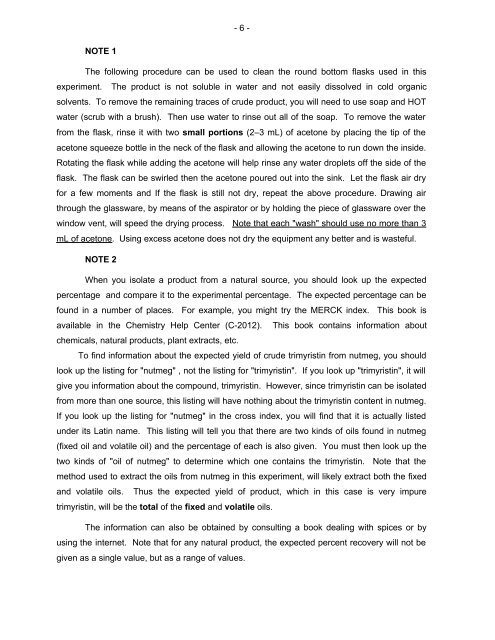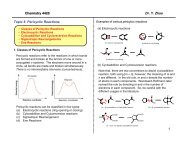crude trimyristin - Chemistry
crude trimyristin - Chemistry
crude trimyristin - Chemistry
Create successful ePaper yourself
Turn your PDF publications into a flip-book with our unique Google optimized e-Paper software.
NOTE 1<br />
The following procedure can be used to clean the round bottom flasks used in this<br />
experiment. The product is not soluble in water and not easily dissolved in cold organic<br />
solvents. To remove the remaining traces of <strong>crude</strong> product, you will need to use soap and HOT<br />
water (scrub with a brush). Then use water to rinse out all of the soap. To remove the water<br />
from the flask, rinse it with two small portions (2–3 mL) of acetone by placing the tip of the<br />
acetone squeeze bottle in the neck of the flask and allowing the acetone to run down the inside.<br />
Rotating the flask while adding the acetone will help rinse any water droplets off the side of the<br />
flask. The flask can be swirled then the acetone poured out into the sink. Let the flask air dry<br />
for a few moments and If the flask is still not dry, repeat the above procedure. Drawing air<br />
through the glassware, by means of the aspirator or by holding the piece of glassware over the<br />
window vent, will speed the drying process. Note that each "wash" should use no more than 3<br />
mL of acetone. Using excess acetone does not dry the equipment any better and is wasteful.<br />
NOTE 2<br />
When you isolate a product from a natural source, you should look up the expected<br />
percentage and compare it to the experimental percentage. The expected percentage can be<br />
found in a number of places. For example, you might try the MERCK index. This book is<br />
available in the <strong>Chemistry</strong> Help Center (C-2012). This book contains information about<br />
chemicals, natural products, plant extracts, etc.<br />
- 6 -<br />
To find information about the expected yield of <strong>crude</strong> <strong>trimyristin</strong> from nutmeg, you should<br />
look up the listing for "nutmeg" , not the listing for "<strong>trimyristin</strong>". If you look up "<strong>trimyristin</strong>", it will<br />
give you information about the compound, <strong>trimyristin</strong>. However, since <strong>trimyristin</strong> can be isolated<br />
from more than one source, this listing will have nothing about the <strong>trimyristin</strong> content in nutmeg.<br />
If you look up the listing for "nutmeg" in the cross index, you will find that it is actually listed<br />
under its Latin name. This listing will tell you that there are two kinds of oils found in nutmeg<br />
(fixed oil and volatile oil) and the percentage of each is also given. You must then look up the<br />
two kinds of "oil of nutmeg" to determine which one contains the <strong>trimyristin</strong>. Note that the<br />
method used to extract the oils from nutmeg in this experiment, will likely extract both the fixed<br />
and volatile oils. Thus the expected yield of product, which in this case is very impure<br />
<strong>trimyristin</strong>, will be the total of the fixed and volatile oils.<br />
The information can also be obtained by consulting a book dealing with spices or by<br />
using the internet. Note that for any natural product, the expected percent recovery will not be<br />
given as a single value, but as a range of values.









